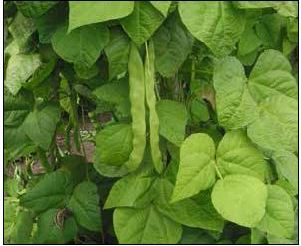BEANS AND PEAS
PH: 5.5-7.0
Plant spacing: 10-30 cm dependent on variety (bush varieties 20-40 plants/m2, climbing varieties 10-12 plants/m2)
Germination time and temperature: 8-10 days; 21-26 °C
Growth time: 50-110 days to reach maturity depending on variety
Temperature: 16-18 °C night, 22-26 °C day
Light exposure: full sun
Plant height and width: 60-250 cm (climbing); 60-80 cm (bush)
Recommended aquaponic method: media bed

Growing beans in aquaponic units: Both climbing and bush bean varieties grow well in aquaponic units, but the former are recommended for less use of space, which maximizes aquaponic bed use. Climbing varieties can also yield 2-3 times more pods than bush varieties.
Beans have low nitrate needs, but have a moderate demand in terms of phosphorus and potassium. Such nutrient requirements make beans an ideal choice for aquaponic production, although excess nitrate may delay flowering. Beans are recommended for newly established units as they may fix atmospheric nitrogen on their own.
Growing conditions for pole beans: Climbing varieties enjoy full sun, but will tolerate partial shade in warm conditions. Plants do not grow at < 12-14 °C. Temperatures >35 °C cause floral abortion and poor fruit set. Optimal relative humidity for plants is 70-80 percent. Beans are sensitive to the photoperiod; thus, it is important to choose the right varieties according to the location and season. In general, climbing varieties are cultivated in summer while dwarf varieties are adapted to short-day conditions (spring or autumn).
Growing instructions for pole beans: For media bed units, seed directly into the grow bed 3-4 cm deep (making sure the bell siphon is out so the water level is high during germination). Beans do not transplant well, which makes them hard to grow in NFT pipes. Any supporting pole should be placed before seed germination in order to avoid root damage. In sowing, care should be taken to avoid future cross-shading with other plants. Beans are susceptible to aphids and spider mites. Although low occurrences of such pests could be controlled with mechanical remedies, attention should be paid to the choice of companion plants to avoid cross-contamination if any treatment has to be carried out.
Harvesting:
Snap bean varieties (green or yellow wax beans) - Pods should be firm and crisp at harvest; the seeds inside should be undeveloped or small. Hold stem with one hand and pod with the other to avoid pulling off branches that will produce later pickings. Pick all pods to keep plants productive.
Shell beans (black, broad or fava beans) - Pick these varieties when the pods change colour and the beans inside are fully formed but not dried out. Pods should be plump, firm. Quality declines if they are left on the plant for too long.
Dried beans (kidney beans and soybeans) - Let the pods become as dry as possible before cooler weather sets in or when plants have turned brown and lost most of their leaves. Pods will easily split when very dry, making seed removal an easy process.